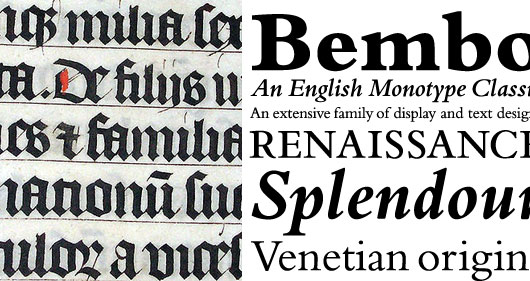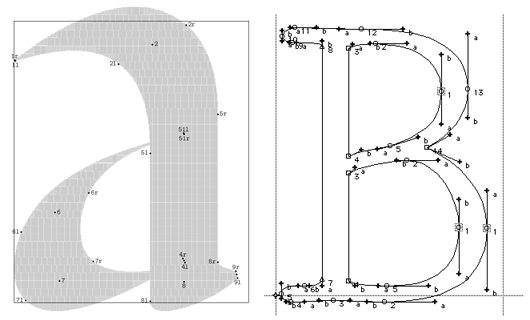Ever since I came across Jürg Lehni’s essay on typographic technology and digital fonts, Typeface As Programme, I’ve been fascinated with the story of Donald E. Knuth and his unexpected contributions to typography.
You see, Knuth is a professor and computer scientist well known to programmers as the author of The Art of Computer Programming, widely regarded as the definitive treatise on the subject. The first of the four current volumes was published in 1968 and Knuth continues to work on it to this day. Truly his life’s work.
Where this story gets interesting for designers like me is what happened in 1977. Knuth was obsessed with making The Art of Computer Programming perfect in every way right down to the print and type.
We didn’t want our papers just to be there, we wanted them to be beautiful. I wouldn’t have wanted to write The Art of Computer Programming if it was going to look ugly.
The first three volumes were stunning. It wasn’t until a new edition of Volume 2 was to be reset with primitive digital type instead of the traditional metal type of the earlier editions that there was a problem. Horrified by the inferior results, Knuth took it upon himself to improve things. After all, digital type was software, right? Determined to develop a solution, Knuth stopped work on his books and devoted himself to typography for the next 10 years. The result: The TeX typesetting system and the Metafont font description language. The combination of the two offered powerful typographic control that hasn’t been matched (even today), especially for complex typesetting like mathematical formulas.
What’s interesting about Metafont is its unique approach to digital fonts. Most fonts are described programmatically as a series of outlines and then filled with a solid color. This allows for perfectly precise and accurate representation but Metafont takes a more fundamental approach. Knuth discovered what every student of typography eventually learns, that the roots of type are in handwriting. Before the invention of printing, documents were written and copied by scribes using a broad nib pen. These flat metal tips, held at an angle resulted in the thick and thin strokes we associate with calligraphy. The typefaces used in the first printed books were meant to mimic the familiar handwritten books they replaced and even today many typefaces owe their thick and thin lines to the tradition of hand drawn letterforms.

While fonts in other systems consist of outlined letterforms Metafont “draws” each letter, simulating the broad nib pen and the actual strokes you’d use to write them by hand. The resulting fonts are not only beautiful but their construction allows for greater control and variation. Rather than simply scaling to different sizes, fonts in this system can be further optimized for things like contrast, stroke, and x-height – essentially redrawn at each size like earlier metal type.

Knuth created TeX and Metafont because he wanted to extend the care he took in his writing to the design and printing of the physical books. He shared them with the rest of the academic community by putting them into the public domain and they’re still popular today, especially in the publication of mathematic and scientific journals.
I’m impressed by Knuth’s refusal to accept the status quo. When it didn’t meet his standards, he simply made something better. But even more I’m inspired by the focused dedication to his life’s work that led him to put down the familiar and immerse himself in a completely different field for an entire decade in order to realize his art.

Obie Fernandez
on 25 May 12great blog post. you have a slight typo “many typefaces owe their think and thin lines”
JZ
on 25 May 12Corrected. Thanks, Obie.
Nate
on 25 May 12“When it didn’t meet his standards, he simply made something better.”
Love it. I try to make sure I remember that everyday. I’ve been heavily on the maker side for years, but it’s so easy to slip into complaining mode rather than sit down and see if something could be made better.
Also with “think and thin lines”, you might have meant “thick”.
Doug
on 25 May 12Raising awareness about TeX grows your karma 100 points.
Dave Hoover
on 25 May 12To find your life’s work is awesome and scary. It takes courage to go after it since it rarely makes sense to others when you start pursuing it. Knuth’s willingness to dive into a different domain is inspiring. Thanks for sharing this.
Matt Harrison
on 25 May 12Knuth is an inspiration. Having just typeset my book using LaTeX, I really appreciate the seeds that Tex has sown.
Mikael
on 25 May 12Here’s a cluster of words about which I find something very compelling, important, and beautiful, but struggle to formulate any clear statement that isn’t reductive or offensive:
... — Knuth — quality — patience — dedication — care — conscientiousness — beauty — love — God — religiosity — …
I’m not being completely flippant when I say that even though I’m quite secular and atheist, Knuth’s life and work is enough to make me appreciate the value of religion.
Martin Clayton
on 25 May 12I couldn’t agree more. The Metafont book is one of my favorite books. Just to prove your point, here’s a quote from the preface:
Joshua McMichael
on 25 May 12Douglas Hofstader has written extensively about Metafont, and I believe it’s some of his most beautiful and interesting work. He discusses Metafont in his collection of essays, “Metamagical Themas”, in a chapter called Variations on a Theme is the Crux of Creativity. I think he also dedicates quite a few pages in to Metafont in Gödel Escher Bach but I wasn’t able to find a link.
James Tauber
on 25 May 12One question I’ve always wondered about: why did Metafont’s approach not take off amongst type designers?
Paul Howson
on 25 May 12Another of Knuth’s remarkable innovations was the concept of “Literate Programming” which made writing software somewhat like writing a book. You can read about it on the web. He practised what he preached by using TEX and Metafont to document both these pieces of software. I still have his beautifully typeset volumes on my shelf, including the one containing the TEX source code intermingled with textbook-quality documentation.
His first book on this topic was called “TEX and Metafont — New Directions in Typesetting”, published in the late 70s. In it he describes his journey and thinking in creating TEX. He also demonstrates some of the possibilities of Metafont, which included fonts that randomly modified their glyph dimensions each time they were imaged. The purpose of this experiment was to replicate digitally the small, random physical imperfections of metal type. A brilliant idea which has not yet entered mainstream font technology, but which would be quite within the capability of modern imaging devices (more so for print than screen use).
Despite all the advances of tools like Adobe InDesign (which by the way borrowed some of the paragraph composition algorithms from TEX), there are still things you can do in TEX which you can’t do in ID. As a part-time book designer, I still use TEX for certain publications. 30 years after its development, there’s still nothing quite like it. A remarkable achievement.
GeeIWonder
on 25 May 12This is the ONLY argument for Metafont, and I’m baffled that it wasn’t made in the parent.
Algorithmic flourishes are no better than graphic ones. They’re just complexity for the sake of complexity.
Until you actually want to DO something where that capability matters, the capability itself can just get in the way (and in both Metafont and TEX, usually do—for all their merits, I’ve seen at least as many journals outright ban the stuff as use it). So what, now I need to install a compiler and libraries to look at your edits? Are you f’in kidding me? Camera ready please.
From a laypersons perspective, the spacing and anchoring text in negative space seem to me to be at least and probably much more the issue in typography as applied today as any of contrast, stroke, and x-height. That’s probably partly the tools, but clearly the tools exist to do this other stuff and people largely, just—don’t.
Would love to see some links examples of THAT (e.g. lifts as implemented in Metafont vs equivalents) if readers here have any handy.
Grant McInnes
on 25 May 12Although I’ve done absolutely no research to back this up, I’d speculate that by the time Knuth started work on TeX and Metafont he was already tenured.
Its inspiring to see one of the few, diminishing examples of tenure (and the university system as a whole) working properly – giving a brilliant individual the opportunity to explore where he saw gaps in our knowledge and capabilities, and then contributing that knowlege back to the common weal.
I fear in these days where researchers are “encouraged” to provide a revenue stream from “intellectual property” a young Knuth would not have had the freedom to do this work
Michael F. Martin
on 26 May 12There will never be another Donald Knuth. A beautiful man.
Dave Crossland
on 26 May 12James Tauber, I wrote a paper on this for TUGBoat and presented it at the annual TUG conference when it was in Ireland a few years ago – http://understandinglimited.com/2008/07/24/why-metafont-didnt-catch-on/
Ricardo
on 26 May 12That doesn’t explain anything. The end result can still be represented by a vector without any difference. The advantage seems to be introducing variation to the outline, which is not clear in the post.
Christian Huund
on 26 May 12In theory, practice and theory are the same, in practice they aren’t. While I admire the capabilities of Metafont I can’t see me using it even for simple outlines like icons. I am using TeX and LaTeX for 20 years but find Metafont still too complicated. There is a very wide conceptual gap between a Metafont program and what it does and I believe this is the reason that graphical font editors like FontLab prevail. (Likewise, the PIC language for Troff on Unix isn’t used much today.) I suggest people take a look at the manual (The Metafont book, you can find bootleg PDFs online) before getting too excited about the strengths of Metafont in the abstract. This doesn’t diminish my respect for Knuth’s work and attitude a single bit.
Jian Meng
on 26 May 12need a example url to how to use it.
Tsybart
on 26 May 12i think that web site must have cool design and typography it very small part.. for the example my site http://iphonemarket.com.ua/ used russian standard text (Cyrillic) and user like this…
alb
on 27 May 12“The combination of the two offered powerful typographic control that hasn’t been matched (even today), especially for complex typesetting like mathematical formulas.”
I believe in giving Knuth his due, but this assertion is over the top. Do you have any familiarity with commercial typesetting systems today? They are excellent at laying out equations and far better than TeX/LaTeX at handling spacing issues. Today, the best you can say about TeX/LaTeX is that it’s about the best open-source solution for complex typesetting. But that’s a far cry from what you asserted.
TeX is great. Knuth is a great programmer. But he’s not made greater by asserting things that just are not true.
José Carlos García
on 28 May 12In fact TeX is the longest-lived, still widely used freesoftware project. First release dates from 1978. (via @jgbarah at http://identi.ca/notice/90321309)
JZ
on 29 May 12@alb – I can’t take credit for that assertion, over-the-top, or not. In my reading it seemed to be a commonly held opinion which even other commenters here have supported.
@Ricardo – I disagree. What struck me is the purity of the approach. “Drawing” with a calligraphic nib results in more authentic curves and variation in weight than simply simulating that effect with outlines. Sure, the net difference in the final output may be negligible, but I admire the novelty of the approach and the hat-tip to the history of type.
GeeIWonder
on 29 May 12Hmmm..
Don’t really mean to pile on but ‘oh, well if that opinion is wrong it wasn’t really mine in the first place’ is weak Wasabi indeed.
I doubt a calligraphic nib results in type more authentic to the first 3 editions, as they were not written with a calligraphic nib. Maybe we should be talking about inking and stamping algorithms if those are the types of curves and variation in weight we’re after.
Illuminated bibles might be what you’re talking about I guess, but they don’t seem to be.
Regardless, it’s an interesting algorithmic exercise, and an impressive application of mindpower to an incidental peeve —usually a cool way to start a project. It’s not the best way to set about writing a book though, unless you’re an algorithmist. Otherwise the whole thing just seems very un-getting real!
Randall
on 29 May 12It’s true that Knuth’s craftsmanship is a wonder of the world and it says a ton that journals still use TeX today. How much 30-plus-year-old software, whose core hasn’t really changed over the years, still gets that kind of deserved respect?
“Modern” fonts and foundries can be more sophisticated than the post suggests, though. The lack of mathematical simplicity isn’t because the font makers don’t know better - fonts like Bembo are sometimes based on physical specimens or hand-cut punches, or are otherwise imitating the quirks of other type makers. And the few control points in Knuth’s fonts hide some complexity-I’ve looked at the programs that ‘draw’ the stems, serifs, etc. and it would take a lot of effort to ever fully understand them. (It’s kind of like a complicated POV-Ray scene-text defining graphics-but it’s really dense code.) Some “modern” fonts have hinting/multiple-master features that mirror Metafont’s customizable variables.
It is a really interesting time for computer typography right now. Low screen resolutions, browser limitations, and lack of freely-licensed fonts conspired to really restrict what text could look like on the Web. It was/is hard to do justice a subtle taper when the strokes are only a pixel thick at text sizes.
All those barriers are dropping now. Hope your blog post gets some readers excited about exploring more than the little corner of typographic space that we’ve all been restricted to for all these years. :)
f
on 29 May 12f
JZ
on 29 May 12“Don’t really mean to pile on but ‘oh, well if that opinion is wrong it wasn’t really mine in the first place’ is weak Wasabi indeed.”
It’s an opinion, it can’t be wrong :)
I’m not a book designer and I don’t have hands-on experience with TeX or Metafont in laying out scientific journals. My reading on this topic revealed that TeX and Metafont’s superiority was a widely-held opinion which I’m reporting here. And it really doesn’t matter. My appreciation is for Knuth’s approach and solution to these problems and for his dedication to his art. The idea that a 30 year old piece of technology is even debatably superior to the modern equivalent is remarkable whether or not it’s universally agreed upon.
Illuminated bibles might be what you’re talking about I guess, but they don’t seem to be.
That’s exactly what I’m talking about. The first moveable type fonts were based on writing, the printed books were made to look like their illuminated forebears. Many fonts still have curves that mimic the line variation of calligraphy but there is a difference between mimicking the effect and replicating the stroke that produced it. That’s the interesting difference in Knuth’s approach.
GeeIWonder
on 29 May 12I guess it’s just that reporting others opinions like sort of puts a Trump stink on things in that ‘I’m not really saying what I’m saying, I’m just reporting what I’m hearing. It’s an interesting question’. We’d maybe all be better off if we reported our own opinions. Soliciting that of others when we aren’t informed enough to have formed one = good. Reporting them as gospel (seems we have a bible theme going) or by count = bad.
Yup. Metafont should be able to do things in calligraphy well, maybe even better. But it’s disingenuous to say that’s what you’ve said above. You’ve weaved a whole narrative about a specific problem of Knuth not having a suitable tool to print his 4th edition, and dropping everything to make a better tool. Then you say that his refusal to accept the status quo and standard develop something better inspire you. What you really mean I guess is his ability to go off and develop toolsets for a completely unrelated problem of calligraphy inspires you.
Part of your problem here is you use these badly defined terms ‘more elegant’ ‘better’—all of which are meaningless until you narrow down what alternatives these things are better THAN and towards what end. Unless you’re just saying they’re all inherently better, in which case I disagree. They’re certainly not more efficient for instance, but nor are they obviously morally better or better at making sandwiches than other alternatives.
But for all that, interesting post. It just could of been a little better than it was if the goal was to celebrate Knuth and TeX and Metafont.
This discussion is closed.